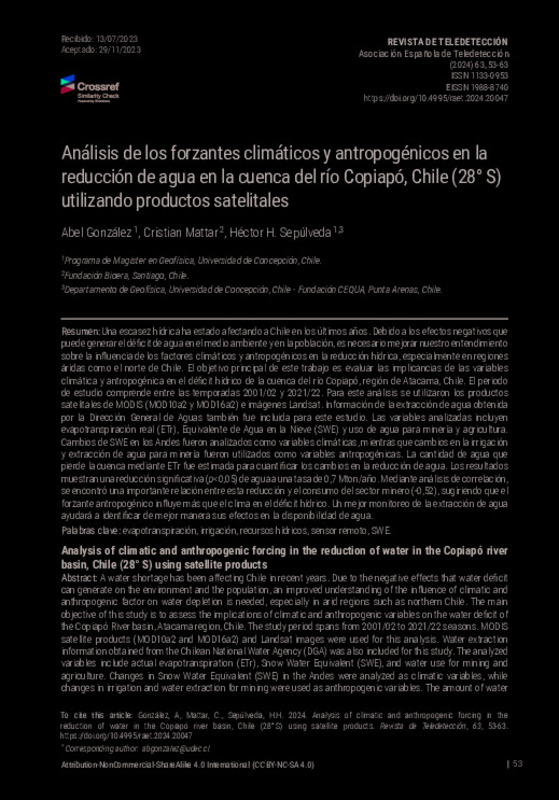|
Resumen:
|
[EN] A water shortage has been affecting Chile in recent years. Due to the negative effects that water deficit can generate on the environment and the population, an improved understanding of the influence of climatic and ...[+]
[EN] A water shortage has been affecting Chile in recent years. Due to the negative effects that water deficit can generate on the environment and the population, an improved understanding of the influence of climatic and anthropogenic factor on water depletion is needed, especially in arid regions such as northern Chile. The main objective of this study is to assess the implications of climatic and anthropogenic variables on the water deficit of the Copiapó River basin, Atacama region, Chile. The study period spans from 2001/02 to 2021/22 seasons. MODIS satellite products (MOD10a2 and MOD16a2) and Landsat images were used for this analysis. Water extraction information obtained from the Chilean National Water Agency (DGA) was also included for this study. The analyzed variables include actual evapotranspiration (ETr), Snow Water Equivalent (SWE), and water use for mining and agriculture. Changes in Snow Water Equivalent (SWE) in the Andes were analyzed as climatic variables, while changes in irrigation and water extraction for mining were used as anthropogenic variables. The amount of water lost by the basin through actual evapotranspiration (ETr) was estimated to quantify changes in water reduction.
The results show a significant reduction (p<0.05) of water at a rate of 0.7 Mton/year. Through correlation analysis, an important relationship was found between this reduction and the consumption of the mining sector (-0.52), suggesting that the anthropogenic forcing influences the water deficit more than the climate. Enhanced monitoring of water extraction will contribute to a more accurate identification of its effects on water availability.
[-]
[ES] Una escasez hídrica ha estado afectando a Chile en los últimos años. Debido a los efectos negativos que puede generar el déficit de agua en el medio ambiente y en la población, es necesario mejorar nuestro entendimiento ...[+]
[ES] Una escasez hídrica ha estado afectando a Chile en los últimos años. Debido a los efectos negativos que puede generar el déficit de agua en el medio ambiente y en la población, es necesario mejorar nuestro entendimiento sobre la influencia de los factores climáticos y antropogénicos en la reducción hídrica, especialmente en regiones áridas como el norte de Chile. El objetivo principal de este trabajo es evaluar las implicancias de las variables climática y antropogénica en el déficit hídrico de la cuenca del río Copiapó, región de Atacama, Chile. El periodo de estudio comprende entre las temporadas 2001/02 y 2021/22. Para este análisis se utilizaron los productos satelitales de MODIS (MOD10a2 y MOD16a2) e imágenes Landsat. Información de la extracción de agua obtenida por la Dirección General de Aguas también fue incluida para este estudio. Las variables analizadas incluyen evapotranspiración real (ETr), Equivalente de Agua en la Nieve (SWE) y uso de agua para minería y agricultura. Cambios de SWE en los Andes fueron analizados como variables climáticas, mientras que cambios en la irrigación y extracción de agua para minería fueron utilizados como variables antropogénicas. La cantidad de agua que pierde la cuenca mediante ETr fue estimada para cuantificar los cambios en la reducción de agua. Los resultados muestran una reducción significativa (p<0,05) de agua a una tasa de 0,7 Mton/año. Mediante análisis de correlación, se encontró una importante relación entre esta reducción y el consumo del sector minero (-0,52), sugiriendo que el forzante antropogénico influye más que el clima en el déficit hídrico. Un mejor monitoreo de la extracción de agua ayudará a identificar de mejor manera sus efectos en la disponibilidad de agua.
[-]
|









